|
[Front Page] [Features] [Departments] [Society Home] [Subscribe]

The Passage of Fire
Kara Everson
This article reports on the aftermath of a severe bushfire in the upper Blue Mountains, New South Wales in November 1982 and examines the adaptations of a range of plant species to enable them to regenerate. Although almost 20 years old, the article has lost none of its relevance.
Background
Aboriginal legend1 tells the story of Wahn, who through a stream of misdeeds was eventually taken to task by Baiame, the Father Spirit. He threw Wahn into the fire till he dwindled to a heap of white ashes. On these Baiame breathed. A white bird appeared on the bough of a gum tree. The ashes had been transformed and Wahn, the White Crow, was born.
The legends of many tribes2 speak of birds that possessed the power of fire. Sometimes an eagle, sometimes a firetail finch, often a crow, they played with fire, commanded it and communicated its uses.
As well as the obvious requirement of cooking and the provision of warmth, Aborigines3 used heat to reduce pain and to stem the flow of blood from wounds. A woman would make a fire before having a child and after the birth use the ash for cleansing and drying the new born infant. Aboriginal children were often observed by early settlers to play with fire in a way unknown and forbidden to European children.
Apart from skilled use of fire in hunting; to drive larger animals into a position where they could be easily killed, whilst at the same time leaving a trail of small animals for the women and children to collect, the Aborigines had an inherent understanding of the variables at play in seasonal influences and species behaviour. Care was taken to avoid burning those parts of plants which yielded edible fruits. Burnt grasslands (Triodia sp.) were known to produce sweet grass after the first rainfall, thus attracting herbivores to hunt.
The explorer, Mitchell, in his 'Journal of an Expedition into the Interior of Australia', published in 1848, observed the interrelation of the Aborigines and their environment: "Fire, grass, kangaroos and human inhabitants seem all dependent on each other for existence in Australia, for any one of these being wanting, the others could no longer continue."
This relationship changed dramatically with European settlement. Studies4 on charcoal levels at Lake George indicate that the maximum firing of forests does not appear to have occurred until the arrival of the Europeans. Here, charcoal particle levels reach to more than 31 times the value of the highest rise seen during the Aboriginal period.
Given some accounts by early settlers. this does not come as a surprise. Consider, for example, the following account5 by the botanist, George Caley. In November 1804, he set out to cross the Blue Mountains. While his men made camp near Burralow Creek, Caley climbed a nearby hill to make a note of their position. Looking back he was alarmed to see an ever increasing pall of smoke.
....."Observing it to increase fast, I began to be afraid the men had set the place on fire and what heightened my apprehension was their never having been accustomed of making fires in the woods. Fear made me instantly run to the place, which I found all on a blaze. Before I had time to enquire how it happened, I was told the fire was no sooner kindled, but the place was all on a blaze, and that it was with the greatest difficulty that they had saved the greater part of the things."
Aboriginal legend 6 tell us that Wahn. the White Crow was forever making mischief.
Adaptation to Fire
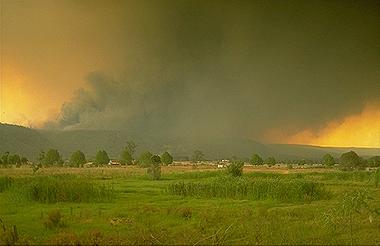 |
|
| Fire in the Blue Mountains |
|
Excluding Antarctica, Australia is the driest of the continents with two-thirds of its area classified as arid or semi-arid. The indirect consequences of this dryness can be seen in the prevalent occurrence of fire and the adaptations of plant species in relation to it.
In November 1982, fire ripped through the northern section of the Blue Mountains National Park, denuding the ridges, laying bare the stark forms of rocks and blackened branches, leaving the countenance of the Grose Valley, its sandstone sentinels, barren and severe. Only the carrion seeking crow called.
.... One year later..
Eucalypts
| |
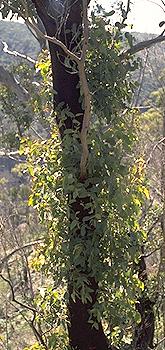 |
| |
Epicormic shoots on a eucalypt |
Let's look at the Eucalypts first, those with effusive growth the length of trunk and lower branches; the most obvious of the survivors. Most eucalypt species of the ridge tops and upper slopes possess lignotubers, a woody swelling at the base of the stem which contains buds and food reserves. These are visible in young saplings, becoming buried as the plant increases in size. The lignotuber develops new shoots rapidly after fire, and or drought. (Lignotubers are also evident in many shrubs and small trees of the Proteaceae, Casuarinaceae and Leguminosae - to name but a few.) Lignotubers are usually accompanied by epicormic buds located within the bark, hence the familiar sight of red tips springing from a black trunk.
The Sydney Peppermint (Eucalyptus piperita), Black Ash (E.sieberi) association of the upper mountains are in this group, having evolved lignotubers to cope with the poorer soils and conditions.
Fire Sensitive Eucalypts
Occurring on the better soils of the lower slopes and gullies - the white ash (E.oreades), Deanes gum (E.deanei) and the Sydney blue gum (E.saligna) are 3 local examples of eucalypts which lack lignotubers. They rely on bark thickness to resist fire. As a protective measure, pale barked gums have been shown' to reflect considerable amounts of radiation in a fire. The darker barks on the other hand, although efficient at absorbing heat are usually too dry to conduct it satisfactorily and thereby help prevent damage.
However, when a high intensity fire does pass through, fire sensitive eucalypts are often killed. Several large ghost-like remnants of white ash can be seen on the lower slopes of the road to Pierces Pass, tangled in giant swarthes of bark. Mysteriously, the unique,uniform stand of Deanes gum in the Blue Gum Forest, by the Grose River, remain unburnt despite the conflagration around it.
Paradoxically perhaps, there is little or no regeneration of these trees without fire. The death of the tree induces an accelerated seed shed. Seeds fall each year and germinate without fire, but are lost due to a variety of factors; predation fungal attack and low light intensity being among the most pronounced. (In relation to Blue Gum Forest, add footsteps here) With the advent of fire, the chances of fungal infection are reduced, light is increased and the seed bed enhanced nutritionally.
This, combined with the rapid and heavy seed fall after fire almost always then results in the initiation of an even aged eucalypt stand. Seedling growth is rapid but seed production does not apparently begin until the stand is approximately 15 - 20 years old. As the species relies on the current seed crop (and not seed stored in the soil as is the case with some legumes) these stands of young trees (up to 20 years) are very vulnerable.
.... One year later..
Flowering After Fire
Many plants have been observed to flower prolifically a year or two after fire. Perhaps one of the clearest fire/flower relationships can be seen in the grass trees (Xanthorrhoea sp.) Without fire, sparse flowering may occur over a period of several years. Fire brings an otherwise unseen abundance. Without it, once again sparseness. Along the ridge tops this November, upthrusts of the pale yellow, nectar laden inflorescences are beacons to bees and small butterflies. At Walls Lookout (off Bell's Line of Road, west of the turnoff to Mt. Banks) an aged one cleaves to the rock face with twin spears framing the Grose Gorge.
Grass Trees (Xanthorrhoea sp.)
The cumbersome word Xanthorrhoea alludes to the resin that flows from the stem of the plant. (Greek xanthos - yellow; rheo - to flow).
This resin has been tested for picric acid (used in the manufacture of explosives).
These distinctive, slow growing trees are a familiar sight all over the Blue Mountains, their blackened trunks testifying to their ability to survive fire.
This is largely due to the fact that while their grass-like leaf crowns burn readily, their tightly packed leaf bases will not. Thus the stem and apex of most mature plants survive a fire and quickly regenerate the crown.
Fire also acts as an actual flowering stimulus7. Factors involved here include: leaf removal, seasonal influence and the effects of ethylene gas produced during the fire. (Ethylene is the gas used to ripen fruit. It is given off in infinitesimal amounts by ripe apples. Hence the homespun advice to bag unripe fruit with a ripe apple.)
In some species (Xanthorrhoea media) flowering starts within 7 or 8 weeks of the fire. In others, such as X.australis, it takes up to 9 months. The flower spikes of this species may reach lengths of up to 2 metres and have more than 10,000 seeds per inflorescence. Highest seed production has been observed to occur after a Spring flowering, when soil moisture was adequate and pollinating insects plentiful7 . The larvae of a particular month (Hyaletis latro) can also make an appearance at this stage and remain on the flowers for up to 12 months causing considerable damage. These grubs are often extracted by black cockatoos.
.... One year later..
Walls Lookout
Despite the fact that the effects of last years fire were particularly severe, in that fire followed, and was followed by drought, the flowers still appear to flourish.
| |
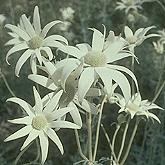 |
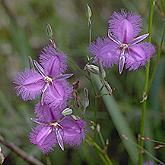 |
| |
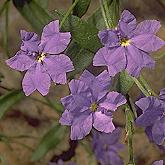 |
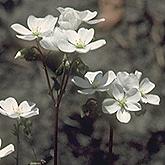 |
| |
Clockwise from top left:
Actinotus helianthi, Thysanotus tuberosus, Drosera binata, Dampiera stricta. |
A walk to Walls Lookout on 26.11.83 saw a profusion of delicate blossoms taking advantage of the open sunlit spaces. Flannel Flowers (Actinotus helianthi) were prolific amid a varied spectrum of violet-mauve Fringe Lilies (Thysanotus sp.) Flag Iris (Patersonia glabrata), Black-eyed Susan (Tetratheca ericifolia), Native Violets (Hybanthus sp.), Tufted Lilies (Sowerbaea juncea) and Dampiera purpurea. Intensities of blue were especially beautiful in Lobeila sp (said to flower only after fire) and the star like Stypandra sp., paler in Dampiera stricta. Golden yellow Drumsticks (Isopogon anemonifolius) with fire tipped foliage occurred near a delicate representative of Goodenia sp. "One of those unfortunate plants that have attracted no common name" (Eric Rolls8). The Broad-leaf Geebung (Persoonia levis) , with its startling array of bright red stems, new green leaves and yellow flowers issuing from a blackened trunk was especially impressive. Sprays of white Teatree (Leptospermurn sp.) blossoming from the trunks of burnt trees provided another stark contrast.
Wild Parsley (Lomatia silaifolia) was in bud. This plant, along with the Sundew (Drosera binata) was mentioned by Gill in his list of plants known to flower abundantly only after fire. Wild Parsley, with its attractive foliage and small white Grevillea-type flowers is common on all soils throughout the Blue Mountains The Sundew, a small plant with white flowers occurs along swamps and creeks. There are some fine specimens at Govett's Leap.
Waratahs and Honey Flowers
| |
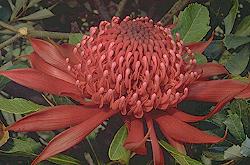 |
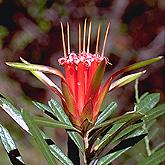 |
| |
Telopea speciosissima (left); Lambertia formosa (right) |
In 1979 the Waratahs (Telopea speciosissima) at Waratah Gardens, Berambing, were burnt. There were no flowers in 1980, prolific flowers in the years following. A recent study9 on the time between fire and the flowering of the Waratah makes the following similar observations.
These observations (Pyke) have shown that the percentage of plants in flower, the average number of flowers per inflorescence (group of flowers on one stem) and the average number of fruits per inflorescence all appeared to peak two years following a summer fire and decline thereafter. The average height of the inflorescence above the ground also increases since the last fire, due to continual growth of the plant which begins from a rhizome after fire. Like the Waratahs, Honey Flowers (Lambertia formosa) shoot from the base after fire. They also appear to achieve a greater mass of blossom 2-3 years after its event.
Ground Orchids
| |
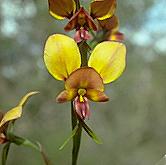 |
| |
Diuris sp. |
Orchids (especially Diuris sp.) are another group of plants known to flower well after fire. They have underground tubers, or thickened stems. Such organs provide valuable protection, as during fire the heat rises, only a small proportion penetrating the soil. The soil itself, being an efficient insulator, confines high temperatures to its surface layers. After the fire has passed through, the orchids, like many of the plants hitherto mentioned, benefit from their increased access to light. Without fire, competition for sunlight leads to a marked decrease in their numbers. Flowering usually reaches a peak 2-3 years after a fire. One local species particularly known for this (Gill) is Lyperanthus nigricans.
These, like many others, seem cautious observations not claiming to be generally applicable, for the forms of response to fire appear in some ways to be as elusive as the forms within the flames themselves. The problems of drawing conclusions, manifold. Erie Rolls watched a forest for 25 years and is still watching. In his book 'A Million Wild Acres/200 Years of Man and an Australian Forest', he drew the following conclusion:
"Not even the elementary question 'If a fire starts do we put it out?' can be answered definitely."
Fire and Banksias
Of the plants which have developed in relation to fire, the Banksia stands out as being both dramatic and familiar. It's often charcoal cones present an intriguing variety of forms and an invitation to the most staid of imaginations. Consequently, a brief look at the adaptive responses of that genus would seem appropriate.
Existing bushes of Banksia ericifolia are killed outright by fire, recovery of the species depending on the accelerated seed shed a fire induces.
Studies10 on B.ericifolia have shown that the post-fire emergence of seedlings is affected by both seasonality and fire intensity. It has been found that seeds are released earlier and quicker from cones exposed to high fire temperature than from those exposed to a low fire temperature. Follicles were usually incompletely opened during the fire, maximum opening normally occurring only after a subsequent drying out of the cones on the killed bushes. Disturbance created by wind or heavy rain shakes the seeds free, thus bringing about variation between seeds in their time of release. Should fire be followed by periods of good rainfall a very large proportion of seed will germinate. New plants mature and produce seed again after 5 - 6 years. A second fire passing through within 5 years would therefore result in the species being lost to the area.
| |
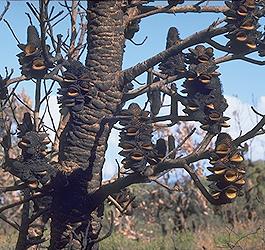 |
| |
Banksia serrata - burnt cones |
Of the banksias occurring in the Hawkesbury/Blue Mountains area B.ericifolia, B.penicillata and B.cunninghamii11 are the only ones to be killed outright by fire. Other species (B.marginata, B.oblongifolia. B.paludosa, B.robur and B.spinulosa var. collina regenerate from lignotubers. a woody swelling at the base of the stem which contains buds and food reserves.
Fire tolerant species such as B.aemula. B.integrifolia and B.serrata regenerate from both lignotubers and epicormic shoots located along the trunk. The trunk is usually protected by bark 1-3cm thick. Fire sensitive arborescent species and the narrow stems of lignotuberous species on the other hand have a bark less than 5mm thick which is unable to protect the stems against fire.
References
The following refer to the reference numbers in the text.
- Aboriginal Myths, Legends and Fables, A.W.Reed, 1977
- The Mara and Kulin tribes of S.E.Victoria both have legends of crows in relation to fire re Bunjil's Cave. Aldo Massola, 1968
- Information taken from Fire and the Australian Aborigine - an Enigma by Phyllis H. Nicholson in Fire and the Australian Biota, Gill, Groves and Noble eds., 1981 Australian Academy of Science
- Quarternary vegetation and fire history in Australia G. Singh, A.P.Kershaw and Robin Clark in Fire and the Australian Biota
- Reflections on the Colony of New South Wales. George Caley. Ed. J.E.B. Curry, 1966
- Reed. p.250
- Adaptive responses of Australian vascular plant species to fires. A. M. Gill in Fire and the Australian Biota
- A Million Wild Acres. 200 Years of Man and an Australian Forest. Erie Rolls, 1981
- Relationship between time since the last fire and flowering in Telopea speciosissima and Lambertia formosa. Graham J. Pyke in Australian Journal of Botany 1983. Vol.31,No.3 ('Analysis possible as a result of studies on the pollination biology of these plants and the foraging ecology of honeyeaters that visit them for nectar'!)
- Fire Effects on Seed Release and the Emergence and Establishment of Seedlings in Banksia ericifolia. R.A. Bradstock and P.J. Myerscough. Australian Journal of Botany 1981 Vol. 29 No. 5.
- Banksia. A.S. George in Nuytsia Vol. 3 (3) 1981.
From Hawkesbury Flora, the journal of the Hawkesbury Group, Society for Growing Australian Plants (NSW), Summer 1983/84 and Autumn 1984.

[Front Page] [Features] [Departments] [Society Home] [Subscribe]
Australian Plants online - December 2001
Association of Societies for Growing Australian Plants
|